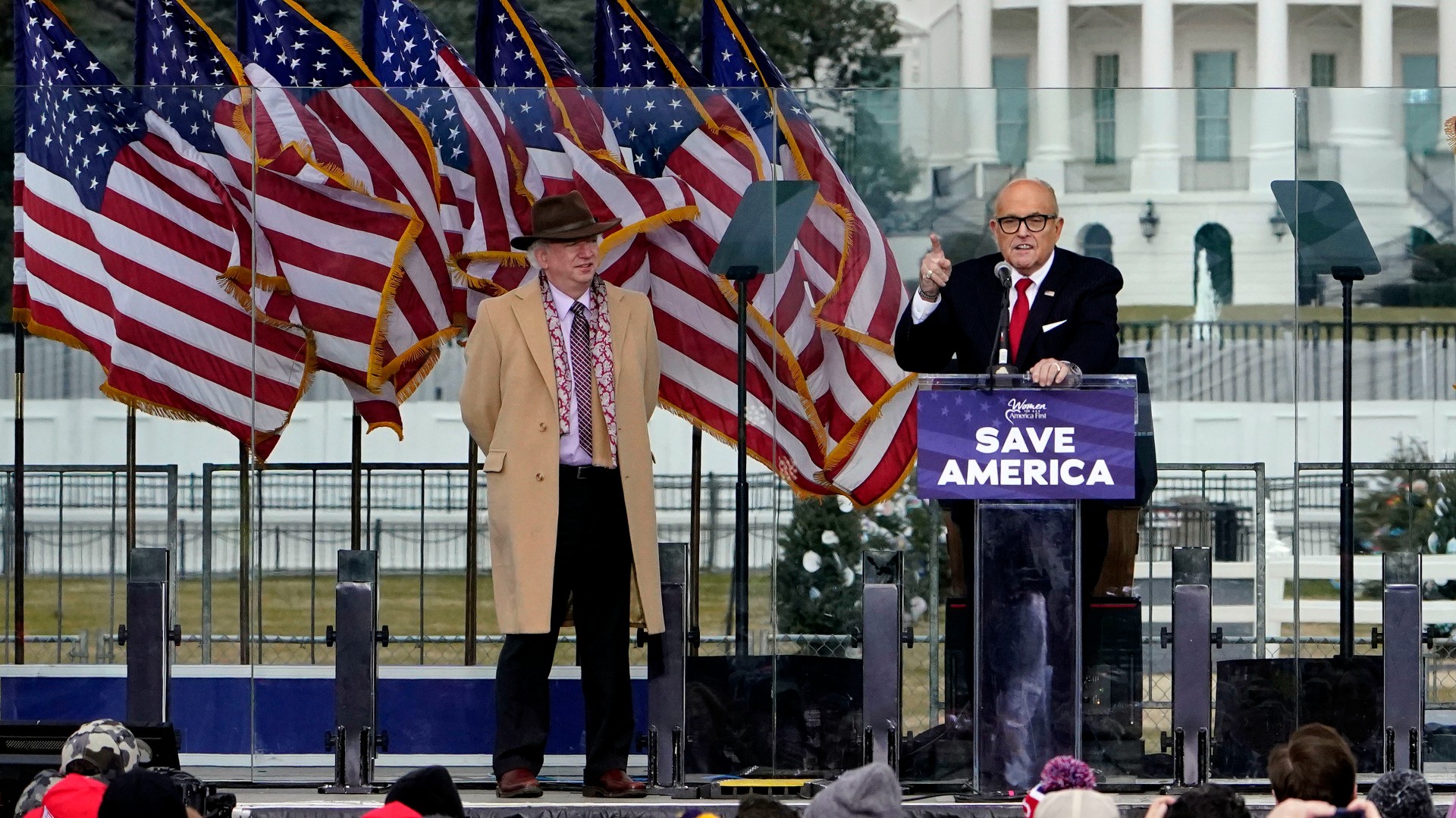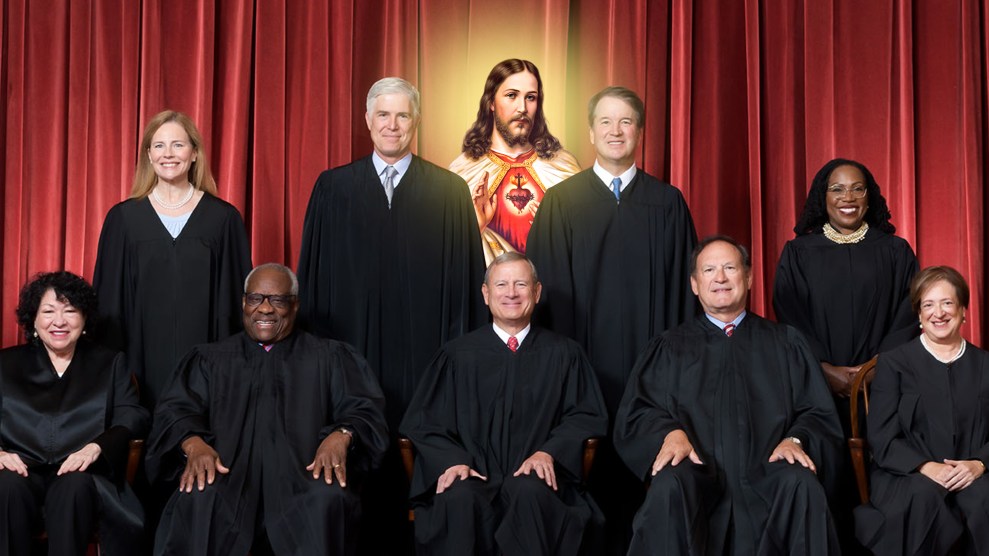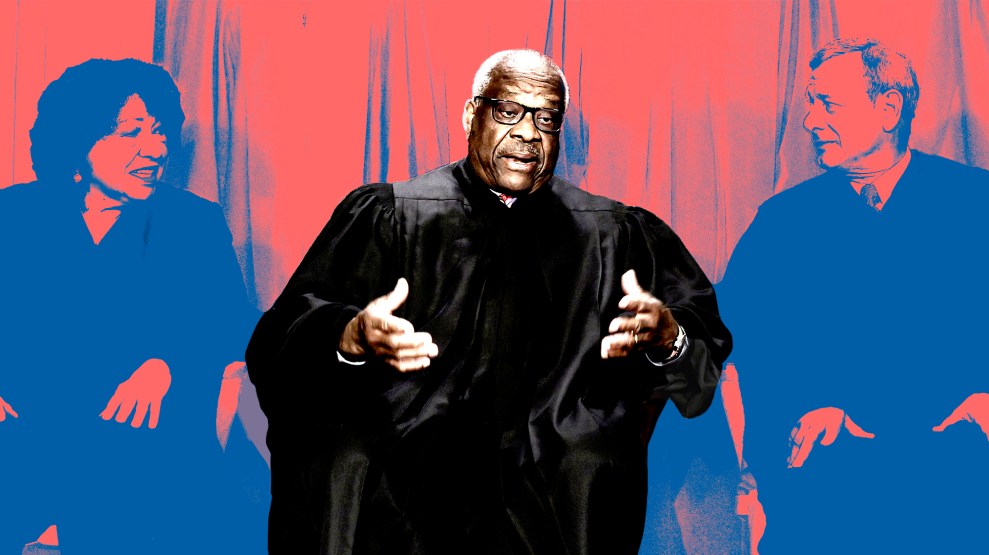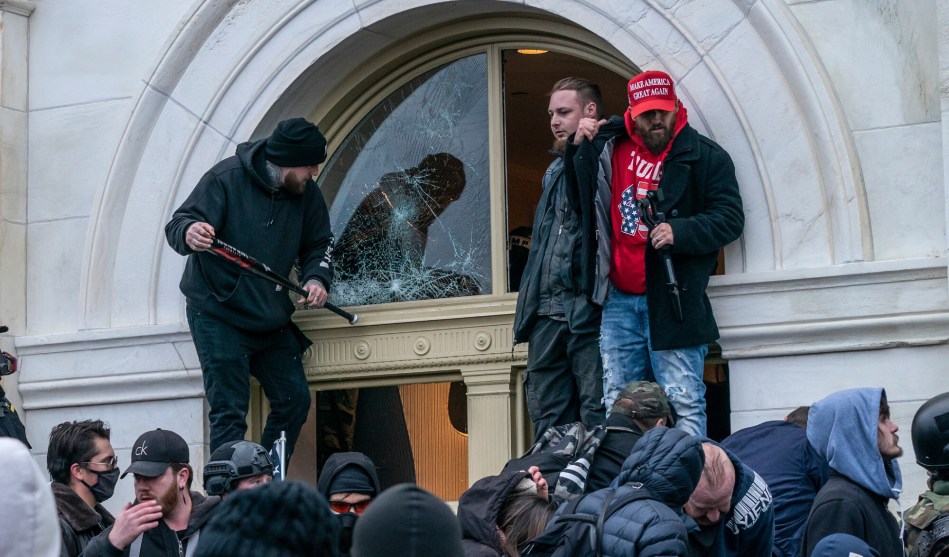Update, June 28: In a major blow to administrative authority, the Supreme Court’s conservative majority overturned Chevron deference.
Among the most consequential decisions in the hands of the Supreme Court this term is a pair of lawsuits involving herring fishermen. On the surface, the nearly identical cases are simple disputes about fishing regulations. But they also have the potential to completely rejigger how federal agencies mediate everything from food and agriculture to taxes and air pollution—because they call into question one of the legal field’s most-cited legal precedents, a 40-year-old doctrine called “Chevron deference.” Many conservatives have sought to kill the legal doctrine for over a decade. And within the chorus, one has sung with notable passion: John Eastman.
That’s the same John Eastman who, on January 6, 2021, stood at a podium in DC beside fellow Trump lawyer Rudy Giuliani and bellowed to an angry crowd that then–Vice President Mike Pence ought to halt the peaceful transfer of power. About three hours later, rioters breached the Capitol. It was also Eastman, documents show, who drafted the “coup memos,” which included a multistep plan for Pence to hand the election to Trump and declared the vice president the “ultimate arbiter” of elections. (Eastman is believed to be an unindicted co-conspirator in Trump’s federal indictment; he is also facing possible disbarment in California. He declined to comment on either situation.)
“Eastman has been part of a project to take down federal regulation for a long time.”
But before getting sucked into the gravitational force that is Donald Trump, Eastman, 64, was the sort of conservative legal figure whose name one might forget, a law professor with a cushy job and a chairmanship at a practice group of the conservative legal organization the Federalist Society. Like most academics, he had his obsessions. His writings, speeches, and media appearances over the last 40 years reveal a man who was constantly questioning federal authority and the administrative state. His writings suggest that he saw federal environmental laws as especially problematic. Applications of popular laws like the Clean Water Act and Endangered Species Act, he’s repeatedly argued, overstep the Constitution and the intentions of the country’s framers, who would have largely left environmental regulation to the states. As Eastman put it in a Supreme Court amicus brief last July, unchecked federal agencies pose a “threat” to the Constitution’s design of separation of powers. In that brief, he urged the court to “end the Chevron experiment.”
While Eastman’s views on the environment are extreme, legal scholars tell me, they aren’t exactly rare. He epitomizes the type of anti-regulatory, Federalist Society–bred legal mind you can expect to see elevated by Trump. “Eastman has been part of a project to take down federal regulation for a long time,” Andy Mergen, a clinical professor of environmental law at Harvard Law School, told me, “which is coming to fruition with these Chevron deference cases.” With the most conservative makeup we’ve seen in decades, the Supreme Court is poised to deliver on that project.
Oddly enough, the original 1984 case that inspired the Chevron deference, Chevron USA v. Natural Resources Defense Council, was widely seen as a victory for conservatives. At the heart of the case was a dispute over the Environmental Protection Agency’s ability to define a “stationary source” of pollution—could it be an entire coal factory? A single smokestack? The Reagan EPA interpreted the Clean Air Act in a way that favored corporations and limited curbing their power.
Upon a challenge, the Supreme Court not only agreed that the Reagan administration’s reading of the law was reasonable, but it also instructed judges in future cases to generally defer to expert agencies’ interpretations of the law when statutes, like the Clean Air Act, were vague. The ruling was meant to limit liberal judges from imposing, as Justice John Paul Stevens wrote at the time, their “personal policy preferences” in decision-making. Through the Reagan and both Bush administrations, Chevron functioned as a tool for deregulation (like weakening Clean Air Act limits), explains David Doniger, a senior attorney and strategist at NRDC who argued the original case before the Supreme Court. On the flip side, he says, under Clinton and Obama, Chevron provided more leeway to enact tougher industry oversight.
As Chevron entered the political arena, so did Eastman: In 1984, he was fresh out of college, graduating cum laude with a bachelor’s in politics and economics from the University of Dallas, and, according to his resume, served as a volunteer for Reagan’s 1980 and 1984 campaigns. He went on to get his PhD at Claremont Graduate School just outside of Los Angeles, with a focus in politics and constitutional law, before heading off to law school at the University of Chicago. His dissertation adviser, William B. Allen, described Eastman over email as “an industrious and consistent student,” who developed his interest in the American founding as an undergraduate.

In grad school, Eastman began expressing a deep-rooted suspicion of federal power. In his 1993 doctoral dissertation, he argued that free public education funded by a national government was at odds with what founders like Thomas Jefferson, who he wrote favored smaller units of government, would have wanted for the country. Sweeping national education “schemes,” he concluded, “have begun to erode the capacity of the American people to govern themselves.”
In 1989, he returned to the University of Dallas to deliver a “Constitution Day Celebration” address. During the speech, he claimed that Congress, which at the time was expected to pass the Americans With Disabilities Act, was “out of control,” according to a transcript published in the student paper shortly after. The new law, he argued, could force libraries to “close the stacks for everyone” because books would be out of reach for people in wheelchairs, or force the YMCA to provide swimming lessons to “people with handicaps,” “including, presumably, quadriplegics.” This “civil rights socialism” raised the question, Eastman told the audience, “How are we going to reclaim a Constitution that has been rendered null and void?” (When reached by email, Eastman declined to respond to a list of questions about his views and suggested I “read the Constitution before casting aspersions on those who seek to uphold it.”)
By the time Eastman started clerking for J. Michael Luttig on the US Court of Appeals for the 4th Circuit in 1995, his conservative views on the Constitution were “well-formed,” according to reporting by the Washington Post. About a year later, he landed a clerkship with Supreme Court Justice Clarence Thomas, a friend he’d reportedly known for years and whose views often aligned with his own, as he told the Post: “I thought, given his background, you know, that his career and his jurisprudence would be more in line with the original understanding of the founding than anybody else’s.”
In the ’80s, the Post reports, Thomas sought education in originalism from the Claremont Institute, a conservative think tank backed by groups like the Dick and Betsy DeVos Family Foundation and the Bradley Foundation where Eastman had served as a research associate, and would later return as a senior fellow.
But if there’s an origin to Eastman’s foray into environmental law, it’d be his work with one unlucky amphibian: the southwestern arroyo toad. In the early 2000s, representing housing developers, Eastman led a challenge to the toad’s listing under the federal Endangered Species Act. In the DC District Court, Eastman challenged not just the listing, but the law itself, arguing that the federal government has no authority under the commerce clause to regulate critters that are confined to one state. He lost the case, and the appeal. But he would get one small victory: Then-Judge John Roberts, dissenting from the DC Circuit Court of Appeals, famously referred to the amphibian as “a hapless toad that, for reasons of its own, lives its entire life in California,” suggesting that he sympathized with Eastman’s argument. Pointing to this line, Democrats questioned Roberts on his support for the ESA during his confirmation hearings a few years later. “A lot of people in the environmental community—everyone knows that line about the ‘hapless toad,’” Harvard’s Andy Mergen told me.
This wasn’t the only time Eastman saw the tyranny of the feds embodied in an animal. In 2010, he ran for California attorney general. At a campaign event, he took on the delta smelt, a tiny, endangered fish, arguing that the federal government’s efforts to regulate the creature “exceeds their constitutional authority” under the commerce clause. He’s also made a similar argument against a controversial sucker fish in Klamath Falls, Oregon, that interfered with farming activity in the region.

Eastman’s attorney general campaign shed some light on his views on science: According to an archived version of its Facebook page, in 2012, his campaign shared a YouTube video claiming “Global Warming is a FRAUD” from a now-defunct conspiracy theory account. Eastman did not respond to a request for comment about this video or his views on climate change.
Eastman lost in the primary with about a third of Republican votes. Then–San Francisco District Attorney Kamala Harris, a Democrat, would go on to win the seat. (A decade later, in 2020, Eastman would pen an infamous Newsweek op-ed questioning whether Harris was eligible to be vice president because, as the daughter of immigrants, he argued, she may not qualify to be a “natural born citizen.” The argument was widely discredited by the legal field, but nevertheless put Eastman on Trump’s radar, according to reporting by the New York Times.)
By the 2010s, Eastman had been a law professor at Chapman University for more than a decade, with a term as dean of the law school under his belt. Colleagues remember him as being generally well respected and liked by students. He pushed to raise the law school’s rankings, which broke the US News & World Report top 100 in 2010. (He also once starred in what appears to be a 2012 university theater production as founder John Adams.)
“What conservatives realized—and I think the Obama administration helped them realize it—was they were never really big fans of an activist, administrative state.”
Around that time, Chevron began to fall out of fashion among conservatives like the late Justice Antonin Scalia and Justice Clarence Thomas, who had in previous legal writings voiced support for the doctrine. As Scott Nelson, a lawyer with Public Citizen, a consumer advocacy group, explains, this had everything to do with the Obama administration. “I think, in practice, what conservatives realized—and I think the Obama administration helped them realize it—was they were never really big fans of an activist, administrative state, or broad delegations of authority by Congress to agencies.”
In 2015, at a Federalist Society panel on judicial deference moderated by then–DC judge Brett Kavanaugh, Eastman railed against “administrative overreach” by the Obama administration on everything from “major immigration policy changes” to “renaming Mount McKinley to Mount Denali” in Alaska. “All of these things are being done by agencies with barely a pretextual read of authority in any statute,” he argued.
Four years later, Eastman doubled down on his case against Chevron. In 2019, at a Federalist Society luncheon panel titled, “Revisiting Judicial Deference,” Eastman joined a group of academics and lawyers, including Roman Martinez, one of the Charles Koch–linked lawyers who kicked off opening arguments for a Chevron case in January. During the panel, Eastman claimed that deference to agencies allowed the Obama administration to, without Congress’ explicit approval, support abortion under the Affordable Care Act and require schools to allow transgender students to use the bathrooms of their choice. “When I say they are making law in direct violation of the separation of powers,” Eastman argued, “that’s the way it works on the ground.” (According to the Obama administration, gender identity was protected under Title IX, and the policy was meant to ensure students could learn in an environment “free from discrimination, harassment, and violence.”)
To Mergen, these sort of meetings are at the heart of the conservative project that Eastman is a part of: “It’s all about getting like-minded folks, and often having conservative judges in the room, and talking through this agenda.”
Eastman’s arguments aren’t just theoretical. In the last 20-plus years as a senior fellow at the Claremont Institute, he has filed hundreds of legal briefs. Several of these were for some of the biggest environmental cases to see the Supreme Court. He weighed in on 2023’s Sackett v. EPA, a case challenging the federal government’s authority to regulate wetlands under the Clean Water Act. In his brief, co-authored with fellow Claremont Institute attorney Anthony T. Caso, the two argued that the EPA and Army Corps of Engineers have “pulled off” a “naked power grab,” overstepping Congress, the courts, and local governments. “This was accomplished because, decades ago, this Court ‘deferred’ to the agencies’ interpretation of the Clean Water Act pursuant to the Court’s troubled Chevron deference doctrine,” they wrote.
The Supreme Court’s Sackett decision, while it didn’t overturn Chevron, effectively cut the amount of protected wetlands in the US by half, as much as an estimated 90 million acres. To scientists, this was a disaster. “It’s the worst thing that’s happened in my conservation life,” a plant biologist in North Carolina told me last year. That’s because wetlands are ecological powerhouses: According to the National Oceanic and Atmospheric Administration, they supply more than half of the country’s seafood, can soak up 1.5 million gallons of floodwater per acre, and absorb 8.1 million tons of carbon dioxide per year. Many environmental lawyers see the preservation of rivers, lakes, forests, and the air—which cross state lines—as an issue of inherently federal concern. “We can’t address clean air and clean water and the preservation of endangered and threatened and migratory species without the power of the federal government,” Mergen says.
Many environmental lawyers see the preservation of rivers, lakes, forests, and the air—which cross state lines—as an issue of inherently federal concern.
But in their concurring opinion, Justices Thomas and Neil Gorsuch point to environmental law as a quintessential example of the wide “deviation” from what the Constitution’s writers intended. The opinion directly cited Eastman and Caso’s amicus brief. To Mergen, the opinion “put a target on” statutes like the Endangered Species Act, which operate under Congress’ authority to regulate interstate commerce. Under Eastman’s view of the law, UC Berkeley environmental lawyer Dan Farber told me over email, “much of federal environmental law would be unconstitutional.”
In July 2023, hot off their Sackett victory, Eastman and Caso filed another brief attacking Chevron, this time in Loper Bright Enterprises, the first of the Chevron pair to be considered by the court. In essence, the case is a challenge to a 2020 rule issued by the National Marine Fisheries Service requiring herring fishermen to pay for observers on their boats, a measure intended to prevent overfishing, and would cost the fishers about $700 per day. But the plaintiffs didn’t just challenge one regulation; they also asked the court to reconsider the agency’s entire authority to interpret the law—and by extension, overturn Chevron.
In their brief, Eastman and Caso hit the same note they’ve been harmonizing for years: “Interpretation of legal texts,” they wrote, “is a job for the courts”—not federal agencies. It likely didn’t take long to tee up the brief: Years before, in 2021, Caso had authored a document published in the Chapman Law Review conspicuously titled “Attacking Chevron: A Guide for Practitioners,” laying out the very argument they put before the court. “The purpose of this article,” Caso wrote, “is to give advocates the foundation in the arguments that can be made to attack deference and ultimately overturn Chevron.”
In January, as oral augments began in the Chevron cases, Eastman was in the midst of a legal defense of his own. As a result of his coup-adjacent efforts, he is facing criminal charges in Georgia and Arizona, and in January 2021 agreed to retire from his job at Chapman University after more than 140 of his colleagues signed a letter calling for his firing. In March, a California State Bar Court judge recommended Eastman be disbarred. If the Bar agrees, he’ll lose the ability to practice law.
But not before he had a chance to weigh in on what could be one of the most far-reaching legal decisions in decades. It’s difficult to overstate just how impactful a ruling to overturn Chevron would be. In the last 40 years, as former DOJ environmental lawyer Sean H. Donahue explains, executive agencies have used their authority under Chevron to interpret all sorts of complex statutes—from the Social Security Act to the Clean Air Act or the Food, Drug, and Cosmetic Act. And if the Supreme Court overturns the doctrine, hundreds of agency regulations could be up for relitigation. It’s “potentially a recipe for massive damage to the administrative agencies’ ability to do their job,” Donahue says.
Overturning Chevron is “potentially a recipe for massive damage to the administrative agencies’ ability to do their job.”
But for conservatives like Eastman, that’s precisely the goal. “Chevron is only one aspect of it,” NRDC’s Doniger says. “It’s all part of a broader plan of enfeebling the power of the federal government.”
Eastman’s role in it offers an indication of where the country might be headed under a second Trump term. “Eastman very much epitomizes the view of the people that Trump is going to bring into office,” Mergen says. “It’s going to be a diminished role for the federal government.” Which, he adds, is “really terrifying for the environment.”

















